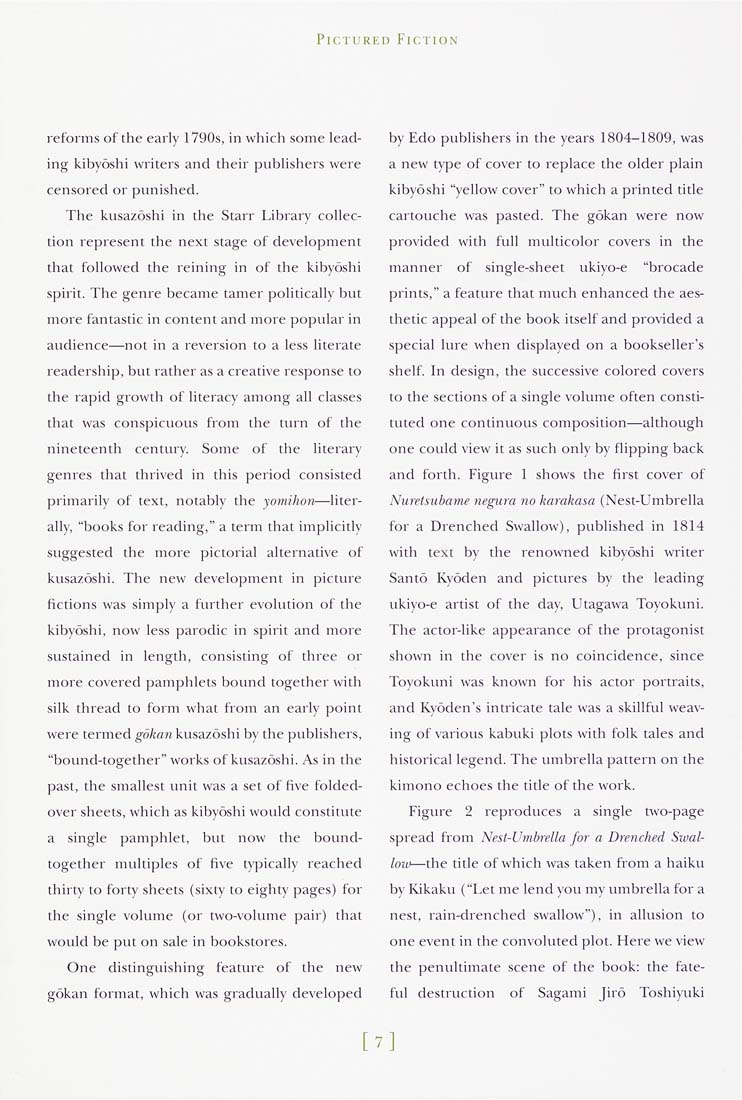Columbia Library columns (v.45(1996))
(New York : Friends of the Columbia Libraries. )
|
||
|
|
|
|
| v.45,no.1(1996:Spring): Page 7 |

Pictured Fiction
reforms of the early 1790s, in which some lead¬
ing kibyoshi writers and their publishers were
censored or punished.
The kusazoshi in the Starr Library collec¬
tion represent the next stage of development
that followed the reining in of the kibyoshi
spirit. The genre became tamer politically but
more fantastic in content and more popular in
audience—not in a reversion to a less literate
readership, but rather as a creative response to
the rapid growth of literacy among all classes
that was conspicuous from the tium of the
nineteenth century. Some of the literary
genres that thri\'ed in this period consisted
primaril)' of text, notably t!ie yomihon—liter¬
ally, "books for reading," a term that implicitly
suggested the more pictorial alternative of
kusazoshi. The new development in pictin^e
fictions was simply a fitrther evolution of the
kibyoshi, now less parodic in spirit and more
sustained in length, consisting of three or
more covered pamphlets bound together with
silk thread to form what from an early point
were termed g-oft^n kusazoshi by the publishers,
"bound-together" works of kusazoshi. As in the
past, the smallest unit was a set of five folded-
over sheets, which as kibydshi woitld constitute
a single pamphlet, but now the boimd-
together multiples of five typically reached
thirty to forty sheets (sixty to eighty pages) for
the single volume (or two-volume pair) that
would be put on sale in bookstores.
One distinguishing feature of the new
gokan format, which was gradually developed
by Edo publishers in the years 1804-1809, was
a new type of cover to replace the older plain
kibyoshi "yellow cover" to which a printed dde
cartouche was pasted. The gokan were now
provided with full multicolor covers in the
manner of single-sheet ukiyo-e "brocade
prints," a feature that much enhanced the aes¬
thetic appeal of the book itself and provided a
special lure when displayed on a bookseller's
shelf. In design, the successive colored covers
to the sections of a single volume often consti¬
tuted one continuous composition—although
one could view it as such only by flipping back
and forth. Figure 1 shows the first cover of
Nuretsubame negura no karakasa (Nest-Umbrella
for a Drenched Swallow), published in 1814
with text by the renowned kibyoshi writer
Santo Kyoden and pictures by the leading
tikiyo-e artist of the day, Utagawa Toyokuni.
The actor-like appearance of the protagonist
siiown in the cover is no coincidence, since
Toyokuni was known for his actor portraits,
and Kyoden's intricate tale was a skillfid weav¬
ing of various kabuki plots with folk tales and
historical legend. The umbrella pattern on the
kimono echoes the title of the work.
Figure 2 reproduces a single two-page
spread from Nest-Umbrella for a Drenclied Sxval-
loxo—the title of ^vhich was taken from a haiku
by Kikaku ("Let me lend you my umbrella for a
nest, rain-drenched swallow"), in allusion to
one event in the convohued plot. Here we view
the penultimate scene of the book: the fate¬
ful destruction of Sagami Jiro Toshiyuki
[7]
|
| v.45,no.1(1996:Spring): Page 7 |







